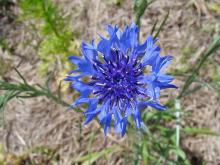Wildflowers, Grasses and Other Nonwoody Plants
Media
Species Types
Scientific Name
Vernonia baldwinii
Description
Ironweeds are tough, grayish-green, branching plants known for their fluffy-looking clusters of reddish-purple florets. They are a familiar sight on roadsides and pastures. Identify western ironweed by the bracts at the base of the flowerheads.
Media

Species Types
Scientific Name
Kummerowia stipulacea (formerly Lespedeza stipulacea)
Description
Korean lespedeza is an Asian clover that was introduced to North America to prevent erosion, to feed wildlife and livestock, and, since it is a legume, to add nitrogen to the soil. A weedy plant, it has spread statewide since the 1930s.
Media

Species Types
Scientific Name
Campanula americana
Description
Tall bellflower is an abundant native bellflower that is easily identified by its stout, tall habit, short, wheel-shaped, blue corolla, and the curved, purple style that projects beyond the flower.
Media

Species Types
Scientific Name
Liatris aspera
Description
Rough blazing star is fairly common and scattered nearly statewide. To distinguish between Missouri’s nine species in the genus Liatris, start by noting details of the flower structure. It’s not hard when you know what to look for.
Media

Species Types
Scientific Name
Carduus nutans
Description
An invasive native of Eurasia that is spreading in Missouri, musk thistle is a plant you should know. Learn how to tell the difference between our native thistles and these bad guys.
Media

Species Types
Scientific Name
Cirsium altissimum
Description
Tall thistle is a native thistle that can grow to be 10 feet tall! To identify it, notice its leaves, which are unlobed (though they may be wavy or have only shallow, broad lobes), are felty-hairy beneath, and have prickles only along the edges.
Media

Species Types
Scientific Name
Centaurea cyanus
Description
A native of Europe, cornflower is a popular garden flower that often escapes to nearby areas. It’s used in bridal bouquets and men’s boutonnieres. Its intense blue color appears in boxes of crayons!
Media

Species Types
Scientific Name
Lactuca floridana
Description
A true lettuce that can be eaten as a cooked or salad green, Florida lettuce has lavender to purplish blue flowers and grows statewide.
Media

Species Types
Scientific Name
Solanum carolinense
Description
Horse nettle is a native perennial with spiny stems and leaves, white to purplish flowers, and toxic fruits that look like tiny yellow tomatoes. It does well in disturbed habitats, and many people consider it a weed.
Media

Species Types
Scientific Name
Sorghum halepense
Description
Johnson grass is a native of the Mediterranean that is invasive in our country. It’s a weed that infests cropland and degrades native ecosystems, and heavy infestations are found in all the major river bottoms of Missouri.
See Also
About Wildflowers, Grasses and Other Nonwoody Plants in Missouri
A very simple way of thinking about the green world is to divide the vascular plants into two groups: woody and nonwoody (or herbaceous). But this is an artificial division; many plant families include some species that are woody and some that are not. The diversity of nonwoody vascular plants is staggering! Think of all the ferns, grasses, sedges, lilies, peas, sunflowers, nightshades, milkweeds, mustards, mints, and mallows — weeds and wildflowers — and many more!





















